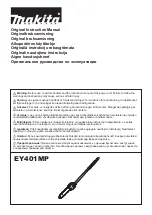
■
TABLE EXTENSION
When cutting wider work pieces, you should
use the table extension (18, Fig.1).
Loosen the knurled screws under the table top
(1).
Pull out the table extension
Fold out the support feet (19, Fig.1)
Re-tighten the knurled screws.
Electrical connection
m
The installed electric motor is connected and
ready for operation. The connection complies
with the applicable VDE and DIN require-
ments.
The power supply provided by the customer
and the applied connection cable have to com-
ply with these requirements as well.
Defective electrical connection cables
Electrical connection cables are a likely sub-
ject to insulation damages.
Causes for that could be:
• Pressure marks that occur when connection
cables are guided through windows or door
gaps.
• Kinks caused by improper fastening or con-
trol of the connection cables.
• Interfaces when overrunning the connection
cable.
• Insulation damages when pulling out the
cable out of the wall socket.
• Cracks caused by the ageing of the insula
-
tion.
Such defective electrical connection cables
may not be used anymore and can be fatal
due to the possible insulation damages.
Check electrical connection cables for da
-
mages regularly. When doing so, ensure that
the connection cable is not connected to the
power supply. Electrical connection cables
must comply with the applicable VDE and DIN
requirements. Use only connection cables
carrying the marking H 07 RN. It is required by
law that connection cables carry the label with
the type designation.
AC motor (alternating current motor)
• The power supply must be 230 Volt – 50 Hz.
Extension cables must have a cross-section
of 1,5 mm2 when shorter than 25 m and a mi-
nimum cross-section of 25 mm2 when longer
than 25 m.
• The power supply is protected by 16 A (slow)
fuse.
Connections and repairs on the elec-
trical equipment may only be perfor-
med by qualified electricians
.
Please submit the following details on request.
• Motor manufacturer
• Type of current of the motor
• Details printed on the machine’s type plate.
Send in the complete drive unit incl. switch
when returning the motor.
Follow the safety instructions!
Cleansing, maintenance and repair
m
WARNING
Remove the plug from the wall socket when working on the electrical power tool itself (e.g. transportation, setup,
conversion, cleansing and maintenance works)!
■
CLEANSING
Let the electrical power tool cool down after
each usage.
Clean the power tool with a moist cloth and a
bit of soap after using it. Use a brush or scrub-
ber for the use in difficult accessible areas.
Note:
Do not use aggressive cleansing agents
or solvents. These could damage the plastic
and metallic components of the electrical
power tool.
Clean the interior of your power tool such
as the gear segment and the pinion of the
slewing mechanism of all wood and splinter
residues regularly
Use an appropriate blunt tool to remove possi-
ble blockages on the suction strainer that were
caused by the sawdust.
WARNING
m
Do not try to remove blockages with
your hand or fingers!
Remove especially persistent residue in inac-
cessible places using compressed air (max.
3 bar).
■
MAINTENANCE
Check the power tool and its accessories (e.g.
tool adaptor) for wear and damages before
and after each usage. If necessary replace
them with new ones according to the instruc-
tions in this manual. When doing so, please
respect the general technical requirements.
Check the saw blade regularly. Use only shar
-
pened, crack-free, not deformed saw blades.
Use only tools that comply with the European
standard EN 847-1.
Replace a worn out stage blade immediately
with a new one of the same type.
Keep the table top free of resin at all times
■
CHANGING THE SAW BLADE FIG. 14, 15
Wear gloves when working with the saw
blade.
Loosen the 2 fastening screws (21) to flip the
saw blade cover upwards.
Place the wring spanner (22) on the clamping
nut, while holding the sidewinder key (23)
against it.
Attention! Loosen the clamping nut in the
running direction of the saw blade.
Take off the saw blade flange and detach the
saw blade diagonally downwards.
Clean both saw blade flanges carefully before
mounting a new saw blade.
The assembly of the saw blade is performed in
reverse order.
Attention!
Pay attention to the running direc-
tion of the saw blade.
■
ADJUSTING THE SPLITTING WEDGE FIG.16, 17, 18
Loosen the wing nut to remove the saw blade
protection (2).
Remove 8 cross-head screws and remove the
stage centre (6).
Loosen the two cross-head screws.
Adjust the splitting wedge (5) in such a way
that the distance to the saw blade is between
3 and 5 mm and that it runs parallel to the saw
blade lengthwise.
Re-tighten both screws.
The adjustment has to be checked each time
after changing the saw blade.
WARNING:
There are no parts inside the electrical
GB
19
Содержание HS81
Страница 2: ...1 20 2 3 9 18 16 10 17 19 15 13 6 12 11 5 7 8 4 14 1 ...
Страница 3: ...4 1 24 20 13 26 27 3 10 11 12 13 14 21 2 2 5 5 11 6 4 14 13 12 8 20 ...
Страница 4: ...15 23 22 16 6 18 max 3 5 mm ...
Страница 52: ......
Страница 53: ......
















































